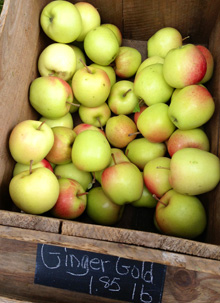
HERITAGE SPECIES Ginger Golds from Meadow
Brook Farm in Raymond, at the Brunswick Farmers’ Market. |
My favorite apple is the sweet-tart GoldRush, a freckled bronze variety much more toothsome than its mundane Golden Delicious parent. Fedco Trees in Clinton says this winter storage GoldRush is “probably the best-tasting apple” to come out of a national program to breed ones immune to that persistent fungus, scab. Unfortunately, I’ve yet to find this newish variety since moving to Maine from Oregon. University of Maine tree fruit specialist Renae Moran says GoldRush is rare in New England, because it doesn’t ripen until very late October, and then it’s often too cold here. Plowshares Community Farm in Gorham is said to have GoldRush trees. And Fedco says GoldRush is gaining in popularity and can usually ripen in time in central Maine.
So I’m searching for my new favorite better suited to this clime. Fortunately, Maine’s cool September nights turn apples sweet and red, and our abundant rainfall this season is actually good for apple-growing. The 2013 crop should be more bountiful than last year’s bust for many orchards, when apples bloomed early in an unseasonably warm March and then blossoms froze off. Some, such as Meadow Brook Farm in Raymond, got creative by spraying their blossoms with water to insulate them from frost, as Florida orange growers do. North of Bangor, Moran says, the crop load is lighter due to rains during pollination, but orchards in the southern half of Maine should have a much better harvest this year.
All Maine apple quests lead to our esteemed pomologist John Bunker (the “Apple Detective”), who began rescuing lost varieties around his Palermo homestead in 1972 and founded Fedco Trees to propagate them. And to David Buchanan, who grows many varieties in his organic Pownal cider orchard he sells as grafts at the Portland Farmers’ Market and describes in his book Taste, Memory: Forgotten Foods, Lost Flavors, and Why They Matter (Chelsea Green, 2012). Bunker and Buchanan, who often join forces for workshops on heritage apple cultivation and cider-making, together uncovered once-favorite Baldwin trees decimated by the 1934 winter, which Urban Farm Fermentory now presses into a dry cider.
For five years now, Bunker and his wife, Cammy, and crew have run an “Out on a Limb” heritage apple CSA, with two drop-off locations in Portland. I just joined and can’t wait for this week’s first pickup of the 10 to 12 pounds of apples. Last year, the CSA distributed dozens of rare and beloved Maine varieties, including deep purple (plum-like) Black Oxfords and dense Blue Pearmains, aromatic Garden Royals and Idareds, Cox’s Orange Pippins and Northern Spys. Willow Pond Farm in Sabattus is known for these late season Northern Spys, crisp yet juicy, and equally good eaten fresh or baked into pie.
I didn’t realize apples are categorized as “dessert” (best eaten fresh) or “culinary” (better when cooked or baked into something). Then of course there are crabapples (great for apple butter) and cider apples, too acerbic to eat raw, but which yield the best alcoholic brews. Bunker says a growing demand for hard cider (from the gluten-free ranks and those otherwise sick of beer) is giving these apples a renaissance.